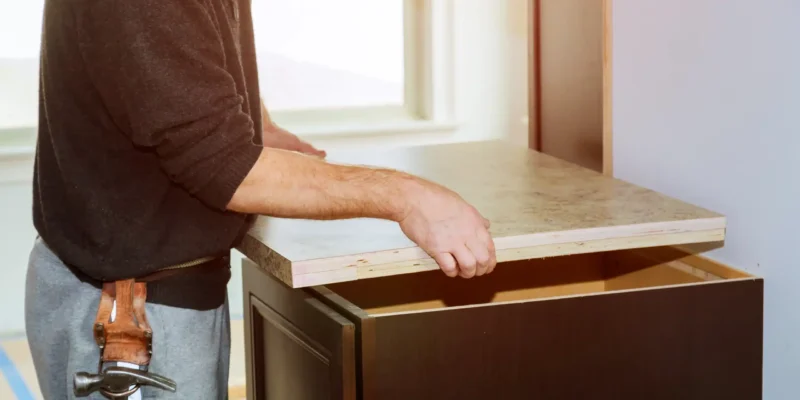When it comes to choosing and installing kitchen countertops in Canada, climate isn’t usually the first thing that comes to mind. But for many regions across the country-from the snowy mountains of British Columbia to the frozen prairies of Alberta and the icy cities of Quebec-cold weather plays a major role in how well materials perform over time.
If you’re a Canadian homeowner planning a kitchen remodel or a full renovation, here’s what you need to consider to ensure your countertops not only look beautiful but also withstand the challenges of Canadian winters.
-
Material Durability in Low Temperatures
While most indoor countertops won’t be directly exposed to extreme weather, Canadian homes-especially older ones-can experience fluctuating interior temperatures during the winter. Poor insulation, cold drafts, and rapid changes in humidity can all affect how some materials behave.
Best choices for cold climates:
- Quartz – Engineered to handle temperature changes better than natural stone.
- Granite – Extremely durable, though sealing is necessary to prevent damage from contraction and expansion.
- Soapstone – Non-porous and thermally stable, making it ideal for cold areas.
Avoid: Materials like laminate or low-quality composite that may crack, warp, or delaminate under thermal stress.
-
Humidity and Moisture Resistance
Canadian winters bring more than just snow-they also bring interior humidity fluctuations. When heaters are on, air dries out; when snow melts near doorways and windows, condensation builds.
This can affect countertop substrates and adhesives.
What to consider:
- Ensure proper sealing for granite, marble, and quartzite to protect from moisture absorption.
- Opt for non-porous surfaces like quartz or porcelain, which resist mold, mildew, and stains.
- Ask your installer about moisture-resistant underlayment and caulking for extra protection.
-
Thermal Shock and Surface Cracking
Thermal shock happens when a material rapidly changes temperature-such as placing a hot pot directly on a cold surface, or vice versa.
In cold Canadian homes where indoor temps can vary drastically, this is a real risk.
Solutions:
- Use heat-resistant materials like granite or soapstone if you prefer to cook often.
- Always use trivets or hot pads-even on supposedly heat-resistant countertops.
- Avoid sudden temperature exposure during or shortly after installation (e.g., don’t crank the heat immediately after install).
-
Proper Installation in Winter Months
Winter installations can be trickier due to:
- Cold adhesive and caulking behavior
- Expansion/contraction of materials in transit
- Potential for moisture in the subfloor
Tips:
- Work with a local installer experienced with winter installations.
- Ensure your kitchen is properly heated during the install period.
- Ask about temperature-stable adhesives and sealants.
- Let materials acclimate indoors for at least 24–48 hours before installation.
-
Energy Efficiency and Heat Retention
Certain countertop materials retain warmth better, which can contribute to energy efficiency and comfort during cold months.
Warm-feeling options:
- Wood or butcher block (though they require more maintenance)
- Soapstone – Naturally absorbs and radiates heat
- Quartz – Slightly warmer to the touch than granite or marble
In open-concept homes where the kitchen is a central space, a countertop that doesn’t feel icy cold is a welcome bonus.
-
Expansion and Contraction Concerns
With drastic temperature swings between day and night (especially in parts of Ontario and the Prairies), some materials may slightly expand and contract-especially those with large surface areas or unsupported spans.
Best Practices:
- Always use professional installers who factor in temperature tolerance.
- Avoid DIY installs in winter months.
- Allow for small expansion joints where needed-especially for large islands.
-
Long-Term Maintenance for Canadian Conditions
Winter in Canada often means more wear and tear: boots dragging in grit, salt particles from shoes, and a generally higher risk of stains and scratches.
Low-maintenance materials:
- Quartz – Requires no sealing, easy to clean
- Porcelain – Ultra-durable and heat/moisture resistant
- Soapstone – Durable, non-porous, and naturally darkens with use
What to avoid in high-traffic cold homes:
- Soft marbles (easily scratched)
- Inexpensive laminates (can bubble and warp)
-
Aesthetic Considerations for Winter-Inspired Designs
Finally, many Canadian homeowners want their kitchens to reflect a cozy, warm aesthetic during the long winter months. Your choice of countertop can contribute to that.
Trending winter-friendly tones in 2025:
- Warm veined quartz (think Calacatta Gold)
- Light granite with taupe or honey accents
- Butcher block mixed with matte black cabinetry
- Natural stone that pairs with under-cabinet lighting for warmth
Conclusion: Make the Right Choice for Your Climate
Choosing the perfect kitchen countertop in Canada involves more than picking a pretty slab. It’s about durability, performance in fluctuating temperatures, and long-term ease of maintenance. Whether you’re upgrading your Toronto condo or building a mountain retreat in Banff, making a climate-conscious decision ensures your kitchen lasts for decades-no matter how harsh the winters.
Need help choosing the best countertop for your Canadian home?
Visit Teccorp Stone to speak with our design experts and browse surfaces built to handle Canadian weather-inside and out.


